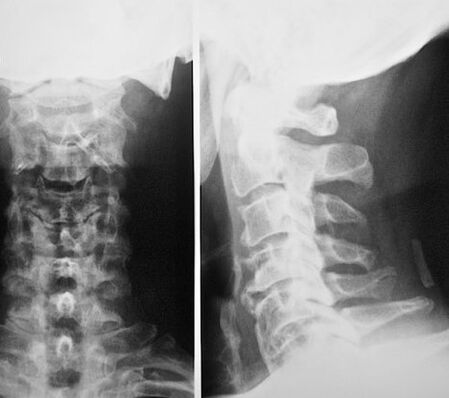Among all of the diseases known to humanity are the most frequently most common motor devices to be supported. It is unlikely that there are a person over 40 years who have no problems with the spine and do not complain about joint pain or muscles. The cause of this phenomenon becomes a seated lifestyle most frequently if the age with a decrease in motor activity, salts and other harmful substances in the joints that disturb the functionality of the bone system are deposited. It is generally recognized that diseases of support and motor ororata only occur among people in mature age, but in recent years, however, this type of illness has often been diagnosed in young people. It is quite difficult to treat such diseases, especially when degenerative - dystrophic changes that affect neighboring cartilage, bones and nerve tissue occur in tissues. A number of diseases that violate the structure of the bone system are given to an illness such as cervical osteochondrosis, a special place that is considered the most common illness of our time and can not only be found in people in mature, but also in young people under 35.

Osteochondrosis of the cervix region is a progressive illness, so that the outdated treatment and later a doctor's colleague can lead to a disability of humans. What is this insidious disease? What are the symptoms of cervical osteochondrosis and how can you deal with this disease?
How does Cervical develop osteochondrosis?
Cervical osteochondrosis is a progressive illness that is characterized by degenerative dystrophic changes in the intervertebral discs, to which deformations are delivered, change their structure, which cause a number of pronounced symptoms. The danger to the development of osteochondrosis of the cervix region are people who have a seated lifestyle or whose professional activity has long been connected to the body in a position. With regard to the incidence of osteochondrosis, the damage to the cervical spine is in second place after lumbosacral osteochondrosis. The peculiarity and complexity of the disease is that the lesion of the cervical region almost always influences the nerve roots of the vertebral nerves and intervertebral discs of the spine, with large and small vessels being defeated by the blood supply to the brain.
The cervical compartment has a complex structure and consists of 7 vertebrae, each of which performs a number of functions: supports the head, turns, bends the neck and other important functions. There are between the vertebrae that make the spine flexible and durable, and the intervertebral discs themselves consist of fibrous rings in which there are imposis. The cervical vertebrae fit close together, which is why even slight physical activity can cause their shift, which in turn means that blood vessels and nerves are pressed. In the cervical spine are the vertebral arteries that are responsible for the brain's blood supply. If it compresses it, blood supply is disturbed, the brain does not receive sufficiently important substances, which undoubtedly leads to its defeat and development of a series of complications, which can lead to a disability of the patient or even death.

The main causes for the neck osteochondrosis
Despite the prevalence of this disease and performance in modern medicine, the pathogenesis of the osteochondrosis of the cervical spine was not completely examined. It is known that the disease can develop against the background of metabolic impairment processes in the cervical spine, which leads to a change in the structure of the intervertebral discs and vertebral body over time. Among other types of osteochondrosis, the cervix is most dangerous, since the nerve roots of the spinal cord and blood vessels are compressed during its development, which undoubtedly leads to a violation of blood supply to brain cells. In the pathogenesis of the disease, doctors differentiate several provocative factors that can lead to the development of the disease.
- A sitting lifestyle.
- Violation of metabolic processes in the body.
- Salt deposits in the cervix region.
- Inadmissible or unbalanced nutrition;
- Long -term interruption of the body in one position: work on the computer, drive a car.
In addition to factors that can lead to the development of cervical osteochondrosis, experts distinguish people who are at risk of developing this disease.
- Genetic predisposition.
- Injuries to the cervical spine.
- Long -term or periodic hypothermia of the body.
- Hormonal imbalance.
- Chronic diseases of the support and motor apparatus: rheumatism, scoliosis, systemic lupus erythematosus.
- Obesity.
The reason for the development of cervical osteochondrosis can be different causes, but in any case the disease should be treated in its first signs.
How can you see osteochondrosis of the cervix region and how are your signs?
Clinical signs of osteochondrosis osteochondrosis of the cervical spine develop slowly. The symptoms of the disease depend on the degree and the number of damaged vertebrae and the clamping of the nerve endings. The main symptom of the disease is the pain of different intensity in the spine, the neck, the lower back, the other organs are given. According to the test results, only a doctor can diagnose "cervical osteochondrosis" because the diversity of the disease clinic often resembles other pathologies, but everyone can suspect this disease.
- The pain in the neck that gives the back of the head, ears, frontal part, forearm, chest, shoulder, shoulder. Painful sensations of different intensities are improved by minimal loads or copy curves.
- Dustiness of the upper and lower extremities, burning, tingling.
- Headache, dizziness.
- A breakdown.
- Darkened in the eyes, "flies" in front of the eyes.
- Fainting with a sharp chin of the head.
- Noise in the ears.
- Doubleity of the language.
- Violation of coordination.
- Reduction of hearing, visual acuity.
- Pain in the heart.

The clinical signs of an osteochondrosis of the cervix region, expressed and appear when the disease develops and progress. Doctors who are involved with the treatment of this disease distinguish several syndromes from cervical osteochondrosis, each of which has their own properties, and manifests itself depending on the damaged nerve spine.
- Rest syndromes - develop as a result of the clamping of the first nerve end pairs in the cervical spine. The patient feels severe pain in the neck, which is given in the shoulder blade, the lower back, shoulder and forearm.
- The syndrome of the spinal arteries is characterized by a pulsating headache in the back of the head or in the temporal region. Burning pain in the neck and neck, which intensify when turning the head, sleep or coughing, gives the chest and shoulder intensified.
- Cardial syndrome is a whole group of symptoms that initially resemble symptoms of angina pectoris. This syndrome develops in the event of damage to the spine of the diaphragm or the large chest muscle. The main signs are considered crushing pain in the heart that does not pass after taking nitroglycerin. Such pain can take several hours and increase when driving or breathing. Such symptoms cause panic in patients because they resemble a heart attack.

Symptoms of a neck osteochondrosis
Cervical osteochondrosis - symptoms and treatment are directly dependent on the damaged nervous spine. The number of cervical roots is 8, and the cervical vertebrae is 7. Every nerve in the neck is above the vertebrae and has its own symptoms.
If there was a defeat of the first and second cervical vertebrae (ci-II), the sensitivity of the back of the head is disturbed, which attracts pain in the parietal and occipital region.
The lesion of the end of the nerve (C3) is extremely rare, but when it is damaged, the patient feels deaf in the area in which the cladding is cladied. Speed, sensitivity of the language is also affected.
The lesion of the C4 nervous spine causes pain and numbness on the collar or shoulder. Diseases in the respiratory system, pain in the heart has been determined.
When the vertebral segment of the 5th department is disturbed, the patient also disturbs the pain that spreads on the shoulder, the outer surface of the shoulder, the sensitivity of the upper and lower extremities.
The roots of C6 and C7 clamp the most common phenomena in patients. The patients feel pain in the neck, sound, forearm, back, lower back, the sensitivity of the hands, disturbed their fingers.
If the nervous spine is affected, the pain in the neck, back and in the elbow is distributed and give the lower limbs. The deafness of the little fingers on the arms and legs can be determined that the sensitivity of the skin is practically missing. The legs and hands of the hands acquire a bluish color due to an impaired blood circulation.
In addition to pain syndromes, a patient with cervical osteochondrosis also complains about other symptoms described in the signs of the disease: impairment of seeing, dizziness, fainting, etc.
Media sports lessons for cervix osteochondrosis
It is necessary to carry out and carry out physiotherapy exercises only after the consultation of a doctor. In addition, the movement should discuss every execution with a specialist, since the wrong position of the neck or limbs can harm health and treatment even more. Consider some secure exercises that can and should be carried out for patients with cervix osteochondrosis.
- In a lying position on a flat surface - spread your arms on the sides. Raise your arms up, turn your body a little on the left with slight movements. The left palms of your hand touch your right palm and vice versa. Do such exercises 5 - 6 times.
- In a lying position on the stomach, stretch your arms on the body. Try to relax your muscles and slowly turn your head left and then to the right. It is necessary to try to touch the floor. Such an exercise can be carried out by default as in the photo. Perform 8 - 10 times.

- When you lie on your stomach, try to lean your chin into your palm, your neck muscles have to be relaxed. Do 5 times.
- Drink your head a little and gradually lower it. The neck muscles will oppose, so such an exercise must be carried out carefully. Repeat the exercise 5-6 times.
- You have to get up and stretch your shoulders. Then slowly turn your head to the right and then to the left. So 5 - 6 times.
- Speak your fingers on the back of the head, put your elbows together and put your forearm chin. Try to increase the reduced forearm as high as possible. Repeat such an exercise 5 - 6 times.
- Take your knees. Lift your head up with slow movements and freeze the body down and stretch your arms forward. So 5 - 6 times.
Physical sports lessons are very effective in the treatment of cervical osteochondrosis, but all exercises must be carried out regularly and correctly. Of course, the disease does not improve from the first classes, so they have to be patient.
Treatment of osteochondrosis of the cervix department with folk remedies
Traditional medicine has also shown its effectiveness in the treatment of cervical osteochondrosis, which has collected a large number of recipes in their arsenal in decades to hundreds of years, which help to reduce the symptoms of the disease. The treatment of osteochondrosis with folk remedies is to use vegetable and animal products for external or internal use.
Recipe 1. Honey made of cervical osteochondrosis. You need 1 - 2 teaspoons of natural bee honey, 2 tablets mummy. Honey and mom have to be heated, put on a warm scarf and attach them to the neck for the night. Honey has a pronounced anti -inflammatory, biostimulating property, so that it can perfectly complement the treatment of this disease.
Recipe 2. Sellerie from osteochondrosis. 4 - 5 grams of celery should be poured with 1 liter of boiling water, 2 - 4 hours, strain and 1 large spoon 3 times a day.

Recipe 3. A decoction of chamomile and olive oil. You need 30 grams of chamomile flowers, 0, 5 l olive oil. Chamber blossoms have to pour into the oil, put on a small fire, bring to a boil and let cool. You have to insist on a decoction for 2 days, then strain it through the full suction and rub the sick areas with the resulting oil. Other herbs can be used together with chamomile: Celandine, Calendula, St. John's spice. If there is no olive oil at hand, you can take sunflowers.
There are other means of traditional medicine that help relieve symptoms of cervical osteochondrosis. However, it is important to remember that such treatment is only effective at the beginning of the development of the disease and can only be used with traditional methods if the treatment is complex.
prevention
The prevention of the neck osteochondrosis is an active lifestyle. In cases where there is a location for the development of this disease, it is necessary to regularly visit a doctor - orthopedic. It is not a less important place of food, which should be useful, rich in vitamins, minerals and other advantageous substances. Prevention or correction of obesity as well as regular physical exercises reduce the risk of repeated development of osteochondrosis.

















































